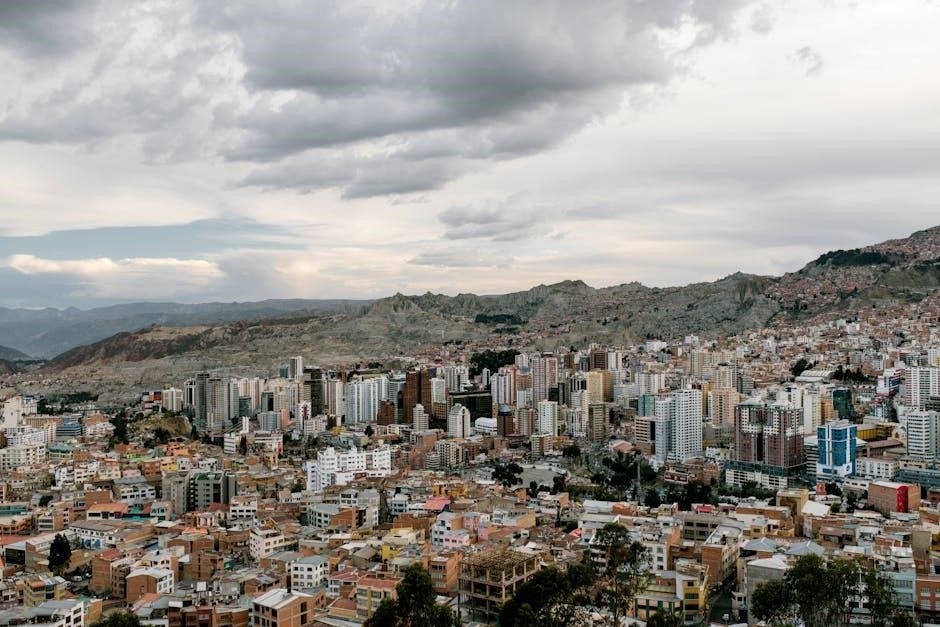This section introduces the topic, exploring Frida Kahlo’s influence and her connection to the Altiplano region, highlighting cultural and artistic elements in the PDF document․
1․1 Overview of “Con Frida en el Altiplano PDF”
The document “Con Frida en el Altiplano PDF” delves into Frida Kahlo’s profound connection to the Altiplano region, exploring how its vibrant culture and landscapes inspired her art․ It highlights her depiction of indigenous traditions, blending personal experiences with regional symbolism․ The PDF also examines Kahlo’s role in preserving Latin American heritage, making it a valuable resource for understanding her cultural impact and artistic legacy in the Altiplano․
1․2 Relevance of Frida Kahlo in Contemporary Culture
Frida Kahlo remains a cultural icon, inspiring modern artists, feminists, and educators․ Her art bridges tradition and identity, resonating globally․ In the Altiplano, her legacy influences festivals, education, and tourism, preserving Latin American heritage․ Her story of resilience and creativity continues to captivate, making her a timeless figure in contemporary culture, symbolizing strength and the celebration of diverse identities․
1․3 The Altiplano Region: A Brief Description
The Altiplano, a vast highland plateau in South America, spans across Bolivia, Chile, and Peru․ Known for its stunning landscapes at over 4,000 meters above sea level, it features salt flats, volcanoes, and traditional indigenous communities․ Rich in cultural heritage, the region is home to vibrant festivals and ancient traditions, making it a unique blend of natural beauty and historical significance․ Its harsh climate and isolated geography have shaped a resilient and resourceful way of life for its inhabitants․
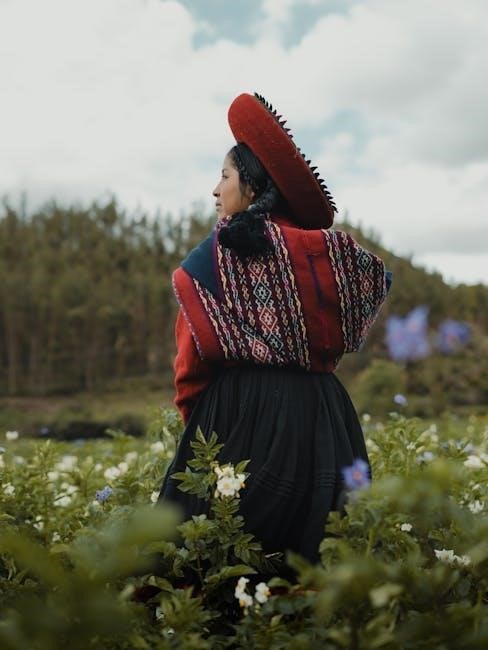
Frida Kahlo’s Life and Artistic Journey
Frida Kahlo’s life was marked by resilience and cultural pride, blending Mexican identity with artistic expression․ Her journey reflects personal struggles, vibrant creativity, and deep connection to heritage․
2․1 Early Life and Influences
Frida Kahlo was born in Mexico City in 1907 to a Hungarian-German father and a Mexican mother․ Her early life was marked by cultural richness and physical challenges․ Her father, Guillermo Kahlo, a photographer, introduced her to art and creativity․ Frida’s home was filled with Mexican folk art and European influences, shaping her unique style․ Her devastating bus accident at 18 altered her life, influencing her art’s emotional depth․ These early experiences laid the foundation for her identity as an artist and a symbol of resilience․
2․2 Key Artworks and Their Cultural Significance
Frida Kahlo’s iconic works, such as The Two Fridas and Self-Portrait with Thorny Necklace, reflect her physical and emotional struggles, blending Mexican folklore with surrealism․ These pieces symbolize her identity, resilience, and cultural heritage․ Her art has become a global symbol of strength, inspiring countless interpretations in the Altiplano region, where her vibrant colors and indigenous motifs resonate deeply with local traditions and artistic expressions․
2․3 Frida Kahlo’s Connection to Latin American Identity
Frida Kahlo embodies the essence of Latin American identity through her art, which blends indigenous traditions, folklore, and personal experiences․ Her vibrant use of color and symbolism reflects the region’s cultural richness․ Kahlo’s portrayal of her own struggles and heritage resonates deeply, making her a symbol of resilience and pride for Latin America․ Her legacy continues to inspire contemporary culture, particularly in the Altiplano, where her work fosters a connection to shared history and identity․
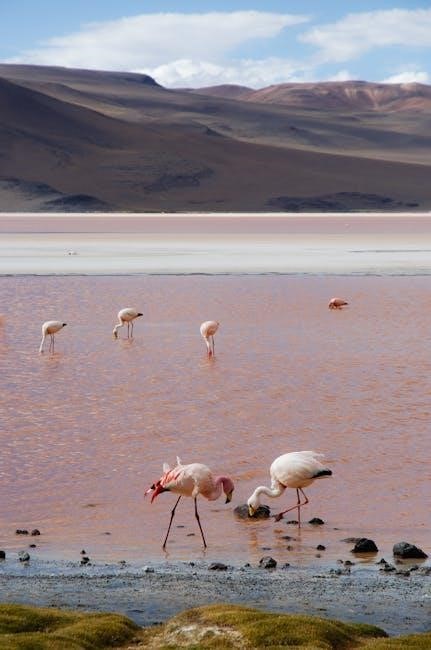
The Altiplano Region: Geography and Culture
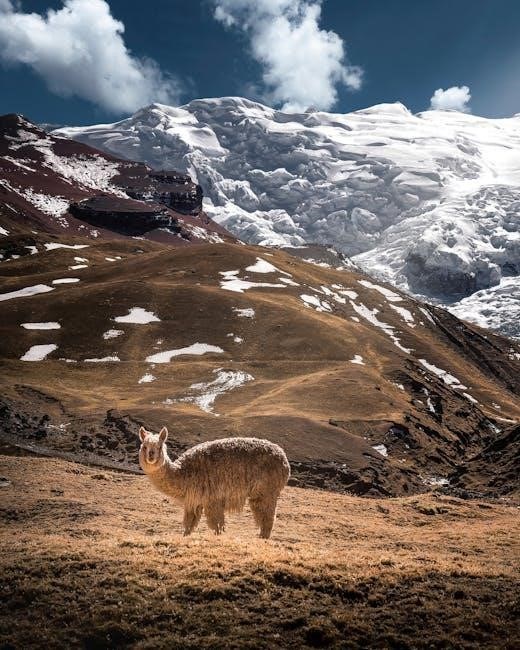
The Altiplano, a vast high-altitude plateau in Bolivia, Chile, and Peru, is known for its striking landscapes and rich cultural heritage, inspiring Frida Kahlo’s artistic vision․
3․1 Geographical Features of the Altiplano
The Altiplano is a vast, high-altitude plateau spanning Bolivia, Chile, and Peru, averaging 4,000 meters above sea level․ Its landscape features include salt flats, volcanic peaks, and pristine lakes like Lake Titicaca․ The region’s arid terrain, with limited vegetation, contrasts sharply with its vibrant cultural tapestry․ Geological formations such as the Salar de Uyuni and active volcanoes like Parinacota highlight its unique biodiversity and natural beauty, which have captivated artists and inspired works like those explored in “Con Frida en el Altiplano PDF․”
3․2 Indigenous Communities and Their Traditions
The Altiplano is home to vibrant indigenous communities, such as the Aymara and Quechua, preserving ancient traditions like textile weaving and ritual celebrations․ Their deep connection to the land is reflected in spiritual practices and communal festivals․ Frida Kahlo’s art depicted similar cultural richness, inspiring modern initiatives․ The FRIDA framework, blending robotics and art, enriches these traditions, fostering cultural preservation through innovative collaboration, ensuring the legacy endures and thrives․
3․3 Historical Significance of the Altiplano
The Altiplano, a high-altitude plateau, holds profound historical significance as a crossroads of ancient civilizations․ It was once home to the Tiwanaku and Inca empires, leaving behind archaeological treasures․ The region’s strategic location facilitated trade and cultural exchange․ Indigenous communities preserved traditions despite colonial influences․ Frida Kahlo’s connection to the Altiplano highlights its enduring cultural legacy, blending pre-Columbian heritage with modern artistic expression, as explored in “Con Frida en el Altiplano PDF․”
Frida Kahlo’s Influence in the Altiplano Region
Frida Kahlo’s artwork draws inspiration from the Altiplano’s vibrant culture, reflecting its indigenous heritage․ Her legacy is celebrated through local art and modern tributes, bridging tradition and contemporary creativity․
4․1 Artistic Inspiration from the Altiplano
The Altiplano’s striking landscapes and rich cultural heritage deeply influenced Frida Kahlo’s work․ The region’s vibrant textiles, indigenous traditions, and natural beauty inspired her use of bold colors and symbolic imagery․ Frida often incorporated elements of the Altiplano’s geography, such as its high plains and traditional attire, into her art, reflecting her connection to Latin America’s diverse identity․ This inspiration bridged the gap between her personal experiences and the broader cultural narratives of the region․
4․2 Frida’s Depiction of Indigenous Culture
Frida Kahlo’s art often celebrated indigenous culture, incorporating traditional textiles, symbols, and themes․ Her work highlighted the richness of Mexico’s indigenous heritage, blending personal identity with cultural pride․ By depicting indigenous motifs and attire, Frida aimed to preserve and honor these traditions, reflecting her deep connection to her roots․ Her art became a bridge between modernity and ancestral traditions, inspiring future generations to embrace their cultural legacy․
4․3 Modern-Day Tributes to Frida in the Altiplano
Modern-day tributes to Frida Kahlo in the Altiplano region reflect her enduring influence․ Locals honor her legacy through vibrant murals, festivals, and art exhibitions inspired by her work․ The FRIDA initiative, blending robotics and art, fosters creativity among youth, while educational programs and workshops celebrate her cultural impact․ These efforts ensure Frida’s spirit remains alive, inspiring future generations to embrace their heritage and artistic expression․
The PDF “Con Frida en el Altiplano”
The PDF explores Frida Kahlo’s influence on Altiplano culture, blending art, identity, and tradition․ It highlights her legacy and the region’s resilience, serving as a cultural bridge․
5․1 Summary of the Document’s Content
The PDF “Con Frida en el Altiplano” delves into Frida Kahlo’s profound influence on the Altiplano region, blending her artistic legacy with the cultural richness of the area․ It explores her connection to indigenous traditions, the inspiration she drew from the region’s landscapes, and her portrayal of Latin American identity․ The document also highlights how Kahlo’s work has inspired modern artistic movements and community projects in the Altiplano, serving as a bridge between tradition and contemporary culture․
5․2 Key Themes and Messages
The PDF “Con Frida en el Altiplano” emphasizes Frida Kahlo’s enduring influence, exploring themes of cultural identity, artistic expression, and social justice․ It highlights her deep connection to Latin American heritage and the Altiplano’s unique landscapes, which inspired her work․ The document also underscores the blending of traditional and modern art forms, showcasing how Kahlo’s legacy continues to inspire contemporary creativity and community engagement in the region․
5․3 Relevance of the PDF in Academic and Cultural Discourse
The PDF “Con Frida en el Altiplano” serves as a valuable resource in academic and cultural discussions, offering insights into Frida Kahlo’s artistic legacy and her connection to the Altiplano․ It bridges art history with contemporary cultural practices, making it relevant for scholars and enthusiasts alike; The document’s exploration of identity, tradition, and modernity provides a unique lens for understanding Kahlo’s influence and the region’s cultural dynamics, fostering dialogue across disciplines and communities․
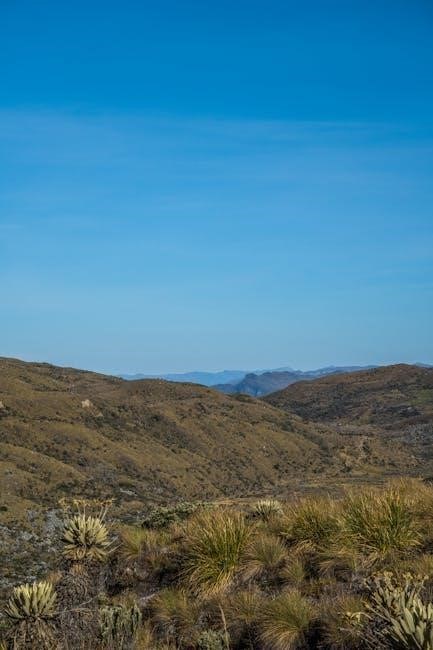
The Role of Art in the Altiplano
Art in the Altiplano reflects the region’s rich cultural identity, blending traditional practices with contemporary expressions, preserving heritage while inspiring innovation and community engagement․
6․1 Traditional Art Forms of the Altiplano
Traditional art forms in the Altiplano, such as textile weaving and pottery, reflect the region’s rich cultural heritage․ Vibrant textiles feature symbolic patterns, while pottery often depicts mythical creatures․ Music and dance, like the “Diablada,” are integral to festivals, celebrating indigenous traditions․ These art forms highlight the spiritual connection to nature and ancestors․ The PDF “Con Frida en el Altiplano” showcases how Frida Kahlo’s art resonates with these traditions, blending indigenous motifs with contemporary styles․
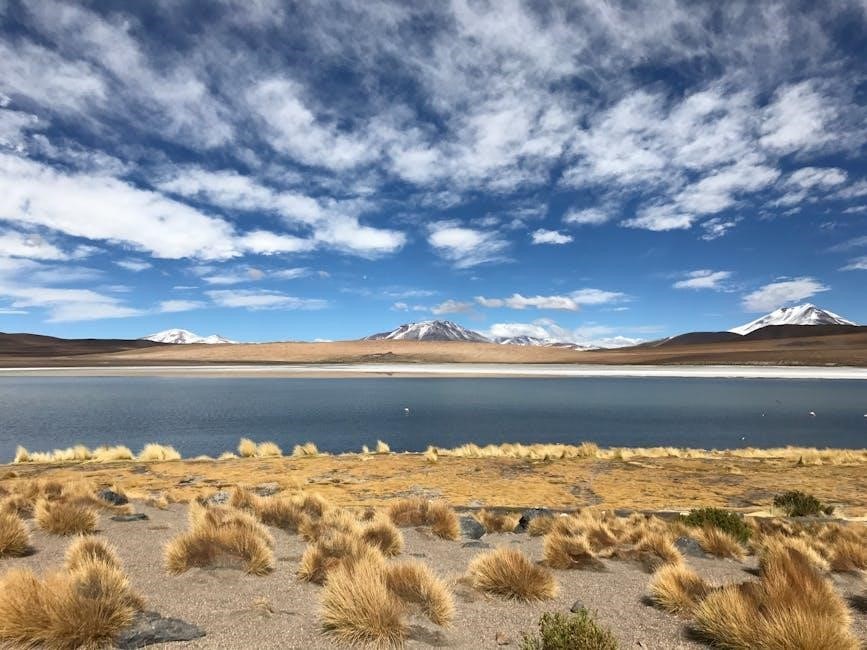
6․2 Modern Artistic Movements Inspired by the Region
Modern artistic movements in the Altiplano draw inspiration from its unique landscapes and cultural richness․ Contemporary artists blend traditional techniques with innovative styles, creating vibrant works that reflect the region’s spirit․ The FRIDA initiative, combining robotics and art, has sparked new creative approaches․ These movements often incorporate Frida Kahlo’s influence, blending bold colors and symbolic motifs․ Community engagement and workshops further nurture these evolving art forms, ensuring the Altiplano’s cultural heritage remains dynamic and relevant in modern times․
6․3 Frida Kahlo’s Legacy in Altiplano Art
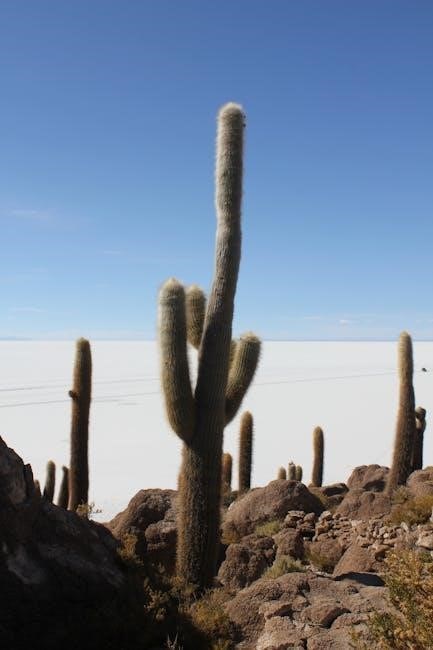
Frida Kahlo’s legacy profoundly influences Altiplano art, inspiring local artists to explore vibrant colors and emotional depth․ Her connection to indigenous culture resonates deeply, blending traditional motifs with modern techniques․ The FRIDA initiative, combining robotics and art, further extends her impact, fostering innovation․ Educational programs and workshops continue to celebrate her influence, ensuring her artistic spirit endures in the region’s creative expressions and cultural identity, bridging past and present․
Cultural Festivals and Celebrations
Cultural festivals in the Altiplano showcase vibrant traditions, music, and dance, reflecting the region’s rich heritage․ Frida Kahlo’s art inspires these celebrations, blending cultural identity with artistic expression․
7․1 Traditional Festivals in the Altiplano
The Altiplano region is home to vibrant traditional festivals that celebrate its rich cultural heritage․ These festivals often feature colorful costumes, traditional music, and dance, showcasing the deep-rooted traditions of indigenous communities․ Rituals and ceremonies, such as the Altiplano’s iconic “Fiesta de la Virgen,” highlight the region’s spiritual connection to its history․ Frida Kahlo’s art often drew inspiration from such cultural expressions, blending them with her own unique style to create timeless works that resonate globally․
7․2 Frida Kahlo’s Influence on Festival Art
Frida Kahlo’s vibrant art and cultural legacy have profoundly influenced festival art in the Altiplano region․ Her iconic self-portraits and symbolic imagery are often incorporated into festival decorations, costumes, and performances․ Traditional parades and celebrations now feature murals and floats inspired by her work, blending her unique style with indigenous traditions․ This fusion not only honors her heritage but also brings her art to life in dynamic, communal settings, ensuring her legacy endures in contemporary cultural expressions․
7․3 The Role of Music and Dance in Altiplano Culture
Music and dance are integral to Altiplano culture, serving as expressions of identity, history, and spirituality․ Traditional instruments like the siku and quena are central to festivals, while dances such as the “Danza de los Cóndores” narrate ancient stories․ These art forms, deeply rooted in indigenous traditions, also reflect the region’s resilience and connection to its heritage․ They provide a vibrant backdrop to celebrations, fostering community unity and cultural preservation, while inspiring modern adaptations that honor their origins․
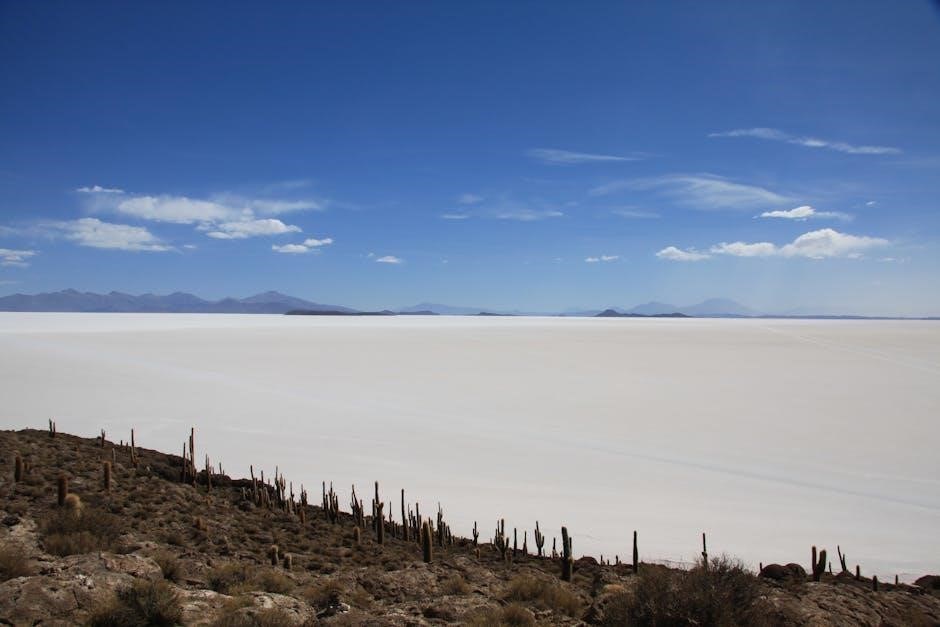
The FRIDA Initiative
The FRIDA Initiative, Framework and Robotics Initiative for Developing Arts, fosters creativity through human-robot collaboration, producing paintings and inspiring artistic innovation while engaging local communities deeply․
The FRIDA Framework, short for Framework and Robotics Initiative for Developing Arts, is an innovative program that combines robotics and artistic collaboration․ It enables humans to work alongside robots to create paintings on canvases, fostering creativity and technological integration․ The initiative aims to promote cultural exchange and artistic innovation, particularly in regions like the Altiplano, where it inspires local communities to explore new forms of expression and engage in educational art projects․
8․2 Robotics and Art Collaboration in the Altiplano
The FRIDA initiative has introduced a unique collaboration between robotics and art in the Altiplano region․ By integrating advanced robotic tools with traditional artistic techniques, local communities can create innovative works that blend modern technology with cultural heritage․ This fusion not only preserves the region’s artistic traditions but also inspires new generations to explore creative expression․ The project fosters a dynamic exchange between artists, engineers, and indigenous groups, enriching the cultural landscape of the Altiplano․
8․3 Impact of FRIDA on Local Communities
The FRIDA initiative has empowered local communities in the Altiplano by fostering creativity and technological skills․ By engaging in robotic art projects, residents, especially youth, gain access to modern tools and global perspectives while preserving their cultural heritage․ This collaboration has strengthened community bonds and promoted economic growth through innovative art production․ FRIDA’s impact extends beyond art, inspiring education and entrepreneurship, thus enriching the region’s cultural and social fabric in lasting ways․

Education and Community Engagement
Educational programs inspired by Frida Kahlo promote creativity and cultural preservation in the Altiplano․ Workshops and art projects engage students, fostering community unity and cultural identity․
9․1 Educational Programs Inspired by Frida Kahlo
Educational programs in the Altiplano region often draw inspiration from Frida Kahlo’s life and art․ These initiatives aim to empower students by exploring themes of identity, resilience, and cultural heritage․ Workshops and interactive activities introduce participants to Kahlo’s artistic techniques, encouraging creativity and self-expression․ By integrating Frida’s legacy, these programs foster a deeper connection to Latin American culture and history, inspiring future generations to value their roots while embracing innovation and diversity․
9․2 Workshops and Art Projects in the Altiplano
Workshops and art projects in the Altiplano region often focus on Frida Kahlo’s artistic legacy, blending traditional techniques with modern interpretations․ These initiatives encourage participants to explore cultural identity and creativity․ Collaborative projects bring together local artists, students, and community members to create murals, textiles, and paintings inspired by Kahlo’s style․ Such endeavors not only preserve cultural heritage but also foster a sense of unity and artistic expression among participants, celebrating the region’s vibrant traditions․
9․3 The Role of Schools in Preserving Cultural Heritage
Schools play a vital role in preserving cultural heritage by integrating Frida Kahlo’s art and legacy into educational programs․ Through workshops and curriculum, students learn about traditional practices, folklore, and the significance of Kahlo’s work in Latin American identity․ These initiatives foster pride in cultural roots and encourage youngsters to explore their heritage creatively, ensuring its survival for future generations while promoting a deeper understanding of the Altiplano’s rich cultural tapestry․
Environmental and Social Challenges
The Altiplano faces environmental degradation, water scarcity, and social inequalities․ Frida Kahlo’s art highlights these struggles, reflecting her deep empathy for marginalized communities and advocacy for justice․
10․1 Environmental Issues in the Altiplano
The Altiplano region faces significant environmental challenges, including climate change, water scarcity, and soil erosion․ These issues threaten the delicate ecosystem and agricultural practices of indigenous communities; Frida Kahlo’s art often reflected her deep connection to nature and her empathy for those affected by environmental struggles, highlighting the importance of preserving cultural and natural heritage in the face of such challenges․
10․2 Social Challenges Faced by Indigenous Communities
Indigenous communities in the Altiplano face significant social challenges, including marginalization, limited access to education, and economic disparities․ These issues often stem from historical injustices and ongoing systemic inequalities․ Frida Kahlo’s work resonates with these struggles, as her art frequently depicted the resilience and cultural richness of indigenous peoples․ Her legacy continues to inspire efforts to address these challenges and promote equality and recognition for these communities․
10․3 Frida Kahlo’s Perspective on Social Justice
Frida Kahlo’s art and life reflected a deep commitment to social justice, particularly for indigenous and marginalized communities․ Her work often highlighted the struggles of the oppressed, blending personal experiences with broader societal issues․ Kahlo’s portrayal of indigenous culture and her advocacy for equality resonated strongly with the Altiplano region․ Her legacy continues to inspire modern initiatives, such as educational programs and cultural preservation efforts, emphasizing the importance of justice and equity․
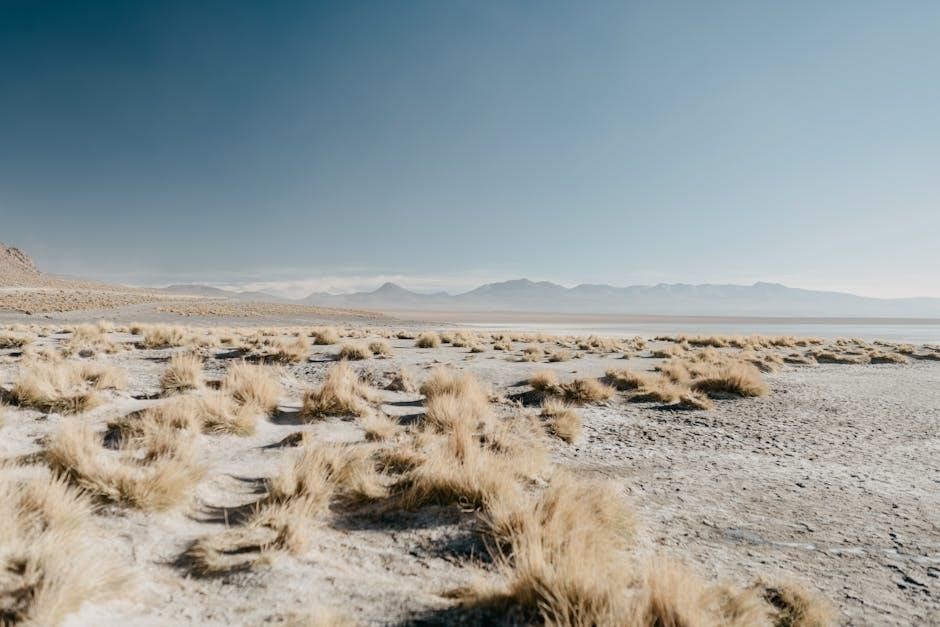
Tourism and Economic Development
Tourism in the Altiplano region, inspired by Frida Kahlo’s art and legacy, drives economic growth and cultural exchange․ Sustainable practices ensure long-term prosperity for local communities․
11․1 Tourism in the Altiplano: Opportunities and Challenges
The Altiplano’s stunning landscapes and rich cultural heritage offer significant opportunities for tourism growth․ However, challenges such as limited infrastructure and environmental concerns must be addressed to ensure sustainable development․
Frida Kahlo’s art and legacy further attract visitors, fostering cultural exchange and economic benefits for local communities․ Balancing tourism expansion with environmental protection remains a critical focus for the region’s future prosperity․
11․2 Frida Kahlo’s Art as a Tourist Attraction
Frida Kahlo’s art serves as a significant tourist attraction, blending vibrant cultural themes and personal narratives that captivate global audiences․ Her work, deeply rooted in Mexican heritage, draws visitors to exhibitions and cultural events in the Altiplano․ The region’s connection to her art fosters a unique blend of artistic appreciation and cultural exploration, making it a compelling destination for those interested in both art and history․
11․3 Sustainable Tourism Practices in the Region
Sustainable tourism in the Altiplano focuses on preserving its natural beauty and cultural heritage․ Eco-friendly accommodations and responsible travel practices are encouraged to protect the region’s fragile ecosystem․ Local communities benefit from tourism through initiatives like traditional art workshops and fair-trade markets․ The FRIDA initiative also promotes cultural preservation, ensuring that tourism growth aligns with environmental and social sustainability goals, making the Altiplano a model for responsible travel․
Frida Kahlo’s legacy endures, inspiring cultural preservation and artistic expression in the Altiplano․ Her influence continues to shape the region’s identity, fostering a future rooted in heritage and creativity․
12․1 Summary of Key Points
Frida Kahlo’s connection to the Altiplano region highlights her profound influence on Latin American culture and art; The PDF “Con Frida en el Altiplano” explores her artistic journey, cultural significance, and enduring legacy․ It delves into the region’s geography, indigenous traditions, and historical importance, showcasing how Kahlo’s work reflects and inspires the Altiplano’s identity․ The document also emphasizes her role in modern artistic movements and community engagement, underscoring her impact on social justice and environmental awareness in the region․
12․2 The Enduring Legacy of Frida Kahlo
Frida Kahlo remains a cultural icon, inspiring generations with her unique art style and resilience․ Her work bridges tradition and modernity, reflecting Latin American identity․ The PDF highlights her lasting impact on art, education, and social justice, showcasing her influence on contemporary movements․ Kahlo’s legacy extends beyond art, fostering cultural preservation and empowerment, particularly for women and indigenous communities․ Her story continues to inspire global audiences, solidifying her role as a timeless symbol of creativity and strength․
12․3 Future Prospects for the Altiplano Region
The Altiplano region faces a promising future, with sustainable tourism and cultural preservation efforts gaining momentum․ Initiatives inspired by Frida Kahlo’s legacy aim to empower local communities and celebrate indigenous heritage․ Education and art programs are fostering growth, while environmental initiatives address climate challenges․ The region’s unique landscape and rich traditions position it as a hub for cultural exchange and innovation, ensuring a vibrant and resilient future for generations to come․

